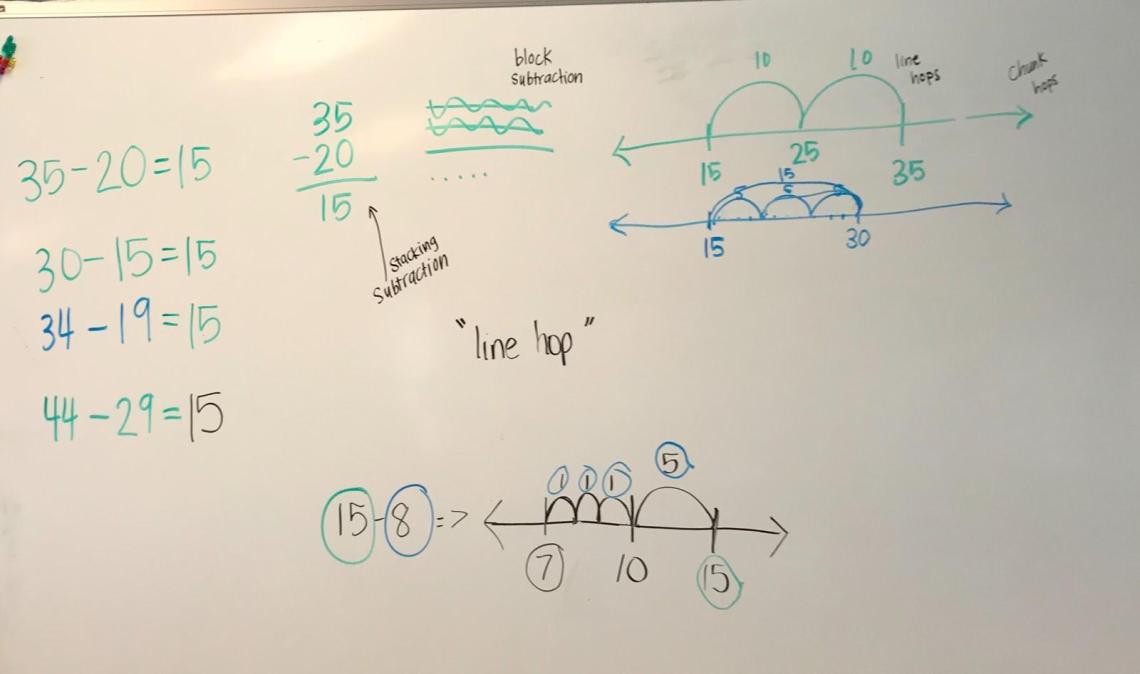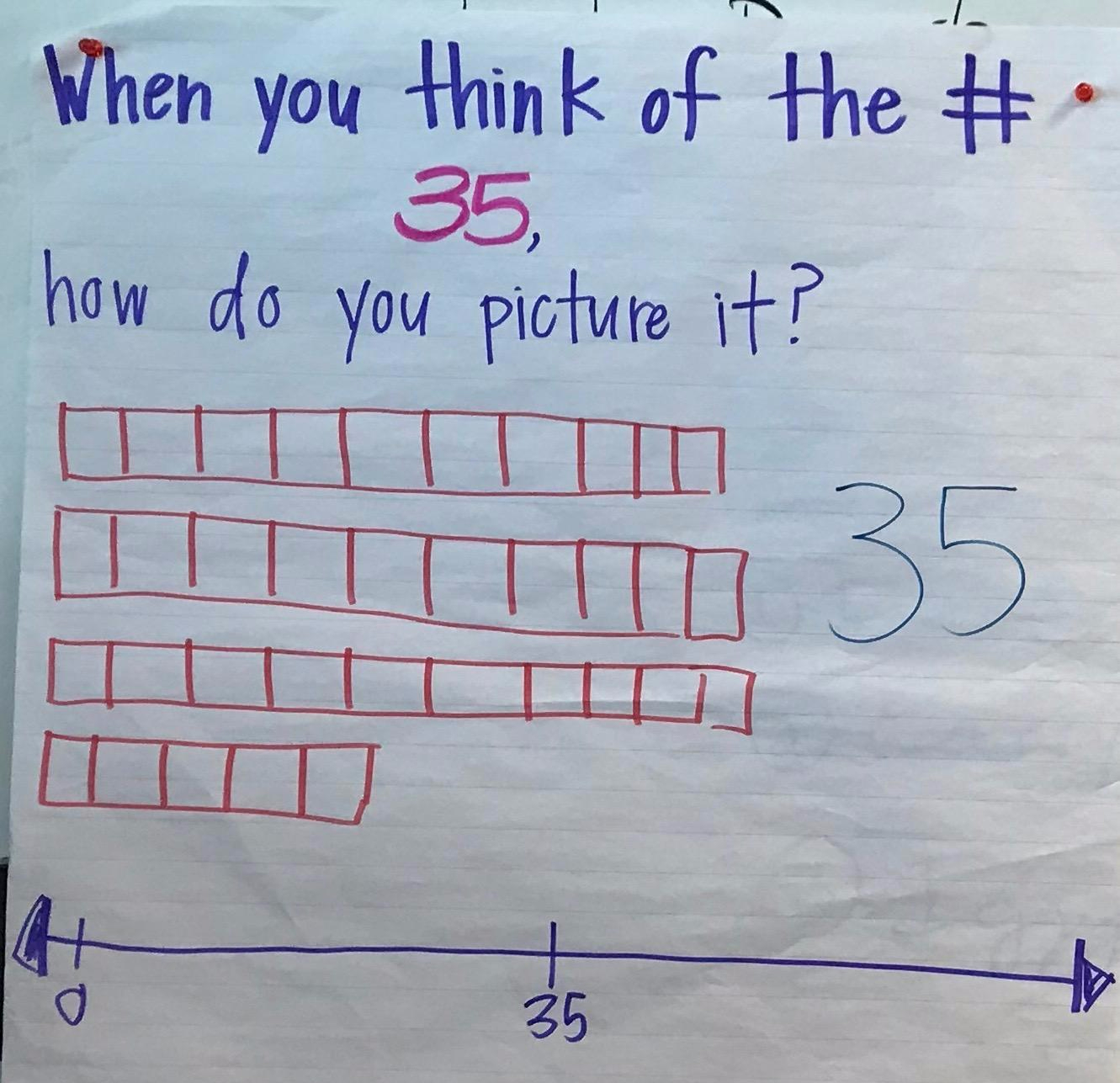How do you plan a number string for a group of learners who are working on very different skills in math? This last spring my pre-service teachers at Chapman University were tutors in a Math Club. Our club was hosted by a school for students with learning differences, and our students ranged from 5th to 8th grade. In terms of their knowledge of operations, our students were at very different places. Some of the students were working on understanding addition and subtraction with smaller numbers, while others were able to quickly compute using all operations with both whole and rational numbers. Each week we started with a whole group math activity, then students would work with their Chapman pre-service tutors.
We work on number strings in class, as a routine that can accomplish multiple goals. Two of my students, Stephanie Weinfeld and Tayler Martin, planned a number string on constant difference in subtraction. They took up the challenge of differentiating this number string in several, interconnected ways. They provided context, models, and made children’s thinking explicit. Below is their narrative . . .
Differentiating a number string for students who are struggling in math can be tricky. Due to the range of levels in the math club, differentiation was crucial. Some students were beginning to understand adding and subtracting, while others in the club were multiplying and dividing multi-digit numbers. This got us thinking, “How can a number string be beneficial and engaging for ALL of the students present?”
The first step in making this number string a little different was making sure that students were ready to see the numbers using different models. We started with an estimation game with band-aids in little plastic jars, showing the number 35 in different ways. After Band-Aids per jar were revealed we posed the question, “when you think of 35, how do you picture it?” Students were given time to discuss this question with each other. In a large group, a few students shared their strategies while we illustrated them on the board for future reference.

Most students shared that they, ‘just pictured the number 3 then the number 5’. With some prompting, some expressed that they imagined Snap Cubes (manipulatives) in 3 ten blocks and 5 ones. In order to provide students with as many visualizing strategies as possible before jumping into the number string, we presented 35 on a number line. The visualizing chart proved to be highly beneficial later on in the lesson when differentiating a number string.
Our second step to differentiate the number string was incorporating contextual word problems. We shared a Shel Silverstein poem about band-aids with the students. Students used connecting cubes to model this, which provided exactly what they would need later- a model of the number 35. Instead of just listing the problems, we made slides with a context, ripping bandaids off a person. The word problems provided a tool where students were really able to visualize the removal of Band-Aids while having fun.

This constant difference number string began with a special number; you guessed it, 35!
Number string:
35-20
30-15
34-19
44-29
Introducing manipulatives in a non-threatening manner made students feel comfortable no matter which strategy they used. We kept the routine true to a typical number string by not suggesting that students take out paper. This was so students had to think outside the box and use the tools around them to solve this number string.
Whole group number string activities support many types of learners because multiple peer strategies are shared and illustrated continuously throughout lessons. Each equation was presented in number string form, individually and sequentially. In addition, this number string was given with corresponding word problems. To provide context, all word problems were written about Chapman tutors and Band-Aids. After reading each problem aloud, students were given ‘think time’ to find an answer.
The goal of this string was to introduce constant difference on a number line. Much like the lesson thus far, a pattern emerged. Initially, all of the students that were sharing their strategy used the standard algorithm to solve. In an attempt to steer students away from the standard algorithm, we then asked them to turn and talk about how they could represent each equation on a number line. After discussion and providing visuals, some students began to imagine these problems on a number line.
Some of the students are most successful when using manipulatives, like Snap Cubes, to solve. However, because there is a wide age range in the club, many students do not want to be the first to use blocks to solve. In order to introduce Snap Cubes in an open and relaxed way, we directed students’ attention to the visualizing chart. We said, “I picture this problem in cubes!” This lead to a discussion about tens and ones blocks, and different ways the class could visualize breaking apart the blocks to find the solution. Students began to use different methods to solve each equation. All around the classroom, we could see some kids using blocks, others a mental representation of constant difference.

Instead of the number string focus remaining constant difference, it became visualizing and strategy practice. As a group, after the last problem of the number string was completed, students collectively named each strategy. The names the class awarded the strategies were line hops, stacking subtraction, block subtraction, and adding to subtract.

We took a fairly simple number string on subtraction and added in multiple entry points for kids. Some kids needed a story to hook them into the problems. Others enjoyed the humor about band-aids and the Shel Silverstein poem. For some kids, they needed the tangible, concrete support of blocks to model their thinking. But ALL kids participated in mathematical discussion, and ALL kids named and identified multiple strategies for subtraction.
